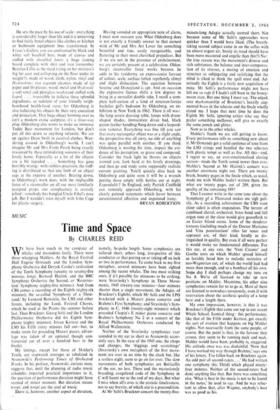Very Lovely Home
ART Anext week's issue will disclose, this is Mr Lowry's month, on home ground, at the Tate; but elsewhere a young American has stolen all the thunder: Claes Oldenburg at the Robert Fraser Gallery. Oldenburg makes a direct and upsetting comment on reality by making enlarged and coloured real objects and stuffing them: light switches, typewriters, hamburgers and so on. At the simplest level his work is the equiva- lent of a kind of poker-faced theatre of the absurd, unsmiling and rather alarming.
He is an important artist though what he is doing stretches the usual boundaries of art: 'Like something halfway between Soutine and Walt Disney,' as an admiring English artist accurately said. The impact of the show, which is a smaller version of one held recently at a museum in Sweden, Oldenburg's native land, is extraordin- ary. You feel like Tom Thumb or Alice in Won- derland in the office-kitchen of some giant and hopelessly misguided race. Whether you are surrounded by art or not is another matter: I often think Oldenburg is really Terry Southern's disruptive millionaire (`Grand) Guy Grand, `making things hot for the people.' Plotting and executing some diabolical public holocaust, the great man muses: 'Are Mr and Mrs Front Porch going to vote this a home run?' And later, in The Magic Chrioian, contemplating another out- rageous exercise worthy of Groucho Marx and the Marquis.de Sade in partnership . . . 'Is this going to spell touch down for Mr and Mrs Front Porch?' If soap opera has to contain all the ingredients of everyday life writ large, then Oldenburg is its Wagner. The only thing is that soap opera has situations and Oldenburg merely supplies the ingredients, leaving you and me to provide the action by our proximity and re- actions to his work. He sets the pace by his use of scale : everything is considerably larger than life and it is unnerving to find fairly banal objects like clothes or kitchen or bathroom equipment thus transformed. In Fraser's Gallery you are confronted by black and white soft baseball bats, made of canvas and stuffed with shredded latex; a huge ironing board complete with shirt and iron (remember Beatrice Lillie as the maid tr) lug on her mistress's big fur coat and collapsing on the floor under its weight?), made of wood, cloth, nylon, vinyl and Hydrostone; two vacuum cleaners made of (a) paper and (b) plaster, wood, metal and Hydrocal; a soft vinyl and plexiglass washstand stuffed with kapok . . . irresistible to italicise these splendid ingredients, so redolent of your friendly neigh- bourhood health-food store, for Oldenburg is also italicising his objects by their very execution and projection. That huge object looming over us isn't a modern erotic sculpture, its a three-way plug. Oldenburg also wants to make an immense Teddy Bear monument for London, but don't put all this down to anything infantile. We are up against Dean Swift in carnival clothes. Wan- dering around in Oldenburg's world, I can't imagine Mr and Mrs Front Porch being exactly reassured by these intimidating souvenirs of their lovely home. Especially as a lot of the objects are a bit lopsided . . . Something has gone horribly wrong : with ruthless precision, the stuff- ing is distributed so that one limb of an object sags at the expense of another. Bearing down, as Oldenburg's work does, with the implacable force of a steamroller on all our most familiarly accepted props, our complacency is severely jolted : somebody has bungled Uncle Ethel's nose job. But I wouldn't trust myself with John Cage for plastic surgery. Having sounded an appropriate note of alarm, I must now reassure you. What Oldenburg does is not exactly a friendly answer to that earnest wish of Mr and Mrs Art Lover for something beautiful and true, easily recognisable, and flattering to their most cherished prejudices. But if we are not in the presence of enshrinement, we are certainly present at a celebration. Olden- burg's steamroller force works because he adds to his taxidermy an expressionist fervour of colour, scale, surface (often repellently slimy) and slight dislocation. The equation between Soutine and Disneyland is apt. And on occasion the expressive licence shifts a few degrees to bring in a surrealist double take. I recall a com- plete half-section of a kind of nineteen-forties bachelor girl's bedroom by Oldenburg, on ex- hibition in New York in 1962. There it all was: the long severe dressing table, lamps with drum- shaped shades, immaculate divan bed, black patent leather handbag flung down and a leopard- skin raincoat. Everything was fine till you saw that every rectangular object was at a slight angle, the perspective was all awry, no side of anything was quite parallel with another. If you think Oldenburg is wasting his time, inspect the evi- dence of his perception, so grave and composed. Consider the fresh light he throws on objects around you, look hard at his lovely drawings, and then go and study some supposedly realistic current painting. You'll quickly dive back to Oldenburg and quite soon it will be a wrench putting those empty milk bottles out at night. Expendable? In England, only Patrick Caulfield can remotely approach Oldenburg, with his clearly painted statements which hover between unsentimental affection and unpointed irony.
BRYAN ROBERTSON



































 Previous page
Previous page